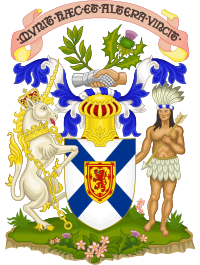
Back Wappen von Nova Scotia German Escudo de Nueva Escocia Spanish Nova Scotia vapp Estonian Armoiries de la Nouvelle-Écosse French סמל נובה סקוטיה HE Герб Новой Шотландии Russian Грб Нове Шкотске Serbian Герб Нової Шотландії Ukrainian
| Coat of arms of Nova Scotia | |
|---|---|
 | |
| Versions | |
 Escutcheon | |
 With orle of maple leaves, used by the Lieutenant Governor of Nova Scotia | |
 Arms of the House of Assembly | |
| Armiger | Charles III in Right of Nova Scotia |
| Adopted | 1625, readopted 1929 |
| Crest | A branch of laurel and a thistle issuing from two hands conjoined, the dexter gauntleted in armour, all proper. |
| Shield | Argent a saltire Azure, overall on an escutcheon Or a lion rampant within a double tressure flory-counter-flory Gules. |
| Supporters | Dexter a unicorn Argent armed crined and unguled Or, crowned with the Royal Crown of Scotland proper, and gorged with a coronet composed of crosses patté and fleurs-de-lis a chain affixed thereto and reflexed Or, sinister a 17th-century representation of a North American Indian holding in the sinister hand an arrow proper. |
| Compartment | A grassy mound Vert set with thistles and mayflowers slipped and leaved proper.[1] |
| Motto | MUNIT HAEC ET ALTERA VINCIT One defends and the other conquers |
The coat of arms of Nova Scotia is the heraldic symbol representing the Canadian province of Nova Scotia. It is the oldest provincial achievement of arms in Canada, and the oldest British coat of arms in use outside Great Britain. It is blazoned as follows: Argent, a saltire azure charged with an escutcheon of the Royal Arms of Scotland.
The arms were originally granted in 1625 by King Charles I for the first Scottish colony on the Canadian mainland. The arms are also borne as a heraldic badge by the Baronets of Nova Scotia, a chivalric order of Great Britain.
They fell out of use when Nova Scotia joined the Confederation in 1867, but were restored in 1929 by royal warrant of King George V.
- ^ "Public Register of Arms, Flags, and Badges of Canada – Province of Nova Scotia". The Governor General of Canada. Retrieved 16 August 2023.